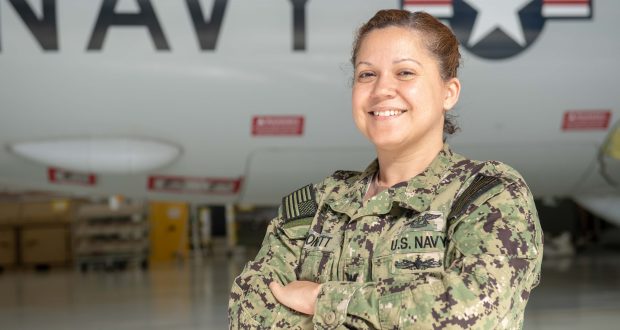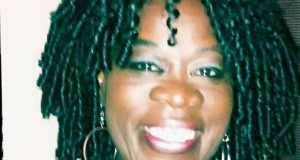By Dustin Good, Navy Office of Community Outreach
OAK HARBOR, Wash. – Petty Officer 2nd Class Eve Symonett, a native of Loma Linda, California, joined the Navy to be able to travel and be a part of a community that’s bigger than a single person.
Now, 10 years later, Symonett serves as a yeoman with the “The Grey Knights” of Maritime Patrol and Reconnaissance Squadron 46, working with the Navy’s cutting-edge maritime patrol and reconnaissance aircraft at Naval Air Station Whidbey Island, Washington.
“This command has a high tempo and alleviates complacency when there is always something going on,” said Symonett.
Symonett, a 1998 graduate of Monterey Bay Academy, with VP-46, a high-tech maritime patrol and reconnaissance squadron, is tasked with monitoring the world’s oceans in the state-of-the-art P-8A “Poseidon.”
Symonett is also currently enrolled at Brandman University seeking a degree in applied studies.
“I’m responsible for administration procedures, office management and customer service,” said Symonett.
Symonett credits success in the Navy to many of the lessons learned in Loma Linda.
“Growing up in my hometown taught me the love of life and appreciation of everything,” said Symonett. “It’s all about balance and if you don’t have that you can’t be successful.”
VP-46’s primary mission is to conduct maritime patrol and reconnaissance as well as long-range anti-submarine warfare, anti-surface warfare and intelligence gathering missions. They deploy around the world to monitor the world’s oceans wherever they are needed.
The P-8A Poseidon, the Navy’s newest maritime, patrol and reconnaissance aircraft, is a replacement aircraft for the legacy P-3C “Orion”. According to Navy officials, leveraging the experience and technology of the successful P-3C “Orion” with the needs of the fleet, the P-8A is designed to be combat-capable, and to improve an operator’s ability to efficiently conduct anti-submarine warfare; anti-surface warfare; and intelligence, surveillance, and reconnaissance missions.
As the Navy transitions to the full capacity with the P-8A “Poseidon”, the aircraft continues the work- horse tradition established by the P-3C “Orion”. The P-8A has a planned state-of-the-art open architecture mission system and next-generation sensors. These capabilities give warfighters added protection. The aircraft empowers the fleet with more combat capability, responsiveness, and interoperability with traditional manned forces and evolving unmanned sensors. The P-8A “Poseidon” has significant growth potential, with planned, phased-in technological improvements that extend global reach, payload capacity and higher-operating altitude.
“The mission overall for the Navy is to bring peace and allow free movement in the sea, so what we do is vital to the mission,” said Symonett.
Serving in the Navy means Symonett is part of a world that is taking on new importance in America’s focus on rebuilding military readiness, strengthening alliances and reforming business practices in support of the National Defense Strategy.
A key element of the Navy the nation needs is tied to the fact that America is a maritime nation, and that the nation’s prosperity is tied to the ability to operate freely on the world’s oceans. More than 70 percent of the Earth’s surface is covered by water; 80 percent of the world’s population lives close to a coast; and 90 percent of all global trade by volume travels by sea.
“Our priorities center on people, capabilities and processes, and will be achieved by our focus on speed, value, results and partnerships,” said Secretary of the Navy Richard V. Spencer. “Readiness, lethality and modernization are the requirements driving these priorities.”
Though there are many ways for sailors to earn distinction in their command, community and career, Symonett is most proud of earning a volunteer achievement medal.
“The community I was raised in was very outreach oriented,” said Symonett. “We were service oriented and we all learned to love others well.”
As a member of one of the U.S. Navy’s most relied upon assets, Symonett and other sailors know they are part of a legacy that will last beyond their lifetimes contributing to the Navy the nation needs.
“Serving in the Navy means being a part of a sub-culture that aims to push the bar higher,” said Symonett.
 Westside Story Newspaper – Online The News of The Empire – Sharing the Quest for Excellence
Westside Story Newspaper – Online The News of The Empire – Sharing the Quest for Excellence




